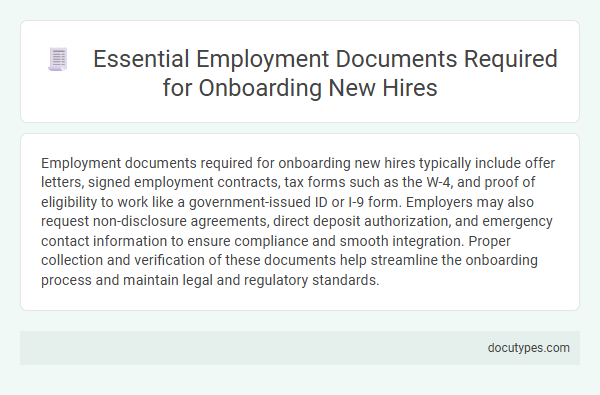Employment documents required for onboarding new hires typically include offer letters, signed employment contracts, tax forms such as the W-4, and proof of eligibility to work like a government-issued ID or I-9 form. Employers may also request non-disclosure agreements, direct deposit authorization, and emergency contact information to ensure compliance and smooth integration. Proper collection and verification of these documents help streamline the onboarding process and maintain legal and regulatory standards.
Introduction to Essential Employment Documents
What employment documents are required for onboarding new hires?
Essential employment documents verify the identity, eligibility, and agreement terms between the employee and employer. These documents ensure a smooth onboarding process and compliance with legal regulations.
Importance of Proper Onboarding Documentation
Proper onboarding documentation is crucial to ensure compliance with legal requirements and streamline the hiring process. Essential employment documents include the employee's identification, tax forms such as the W-4, and employment eligibility verification like the I-9 form. Accurate and complete documentation helps protect the employer, facilitates smooth integration of new hires, and promotes a professional workplace environment.
Employment Offer Letter and Acceptance
Employment documents are essential for a smooth onboarding process. The Employment Offer Letter and Acceptance form the foundation of new hire agreements.
- Employment Offer Letter - This document outlines position details, salary, benefits, and start date.
- Acceptance of Offer - Your signed acceptance confirms agreement to the terms stated in the offer letter.
- Legal Compliance - Both documents ensure compliance with labor laws and company policies during hiring.
Employee Identification and Verification Forms
Employment documents required for onboarding new hires primarily include employee identification and verification forms. These forms help confirm the new hire's identity and eligibility to work legally.
Commonly required documents are government-issued IDs such as a driver's license or passport, along with Social Security cards or work authorization documents. Employers often use Form I-9 in the United States to verify employment eligibility and identity.
Tax Forms and Withholding Statements
Employment onboarding requires specific tax forms and withholding statements to ensure compliance with legal and financial regulations. These documents are essential for accurate payroll processing and tax reporting.
- Form W-4 - Determines federal income tax withholding based on personal and financial information.
- State Withholding Certificate - Establishes state tax withholding according to local tax laws.
- Form I-9 - Verifies your eligibility to work in the United States through identity and employment authorization.
Employment Eligibility Verification (Form I-9)
| Employment Document | Description | Purpose | Compliance Requirement |
|---|---|---|---|
| Employment Eligibility Verification (Form I-9) | The Form I-9 is a U.S. Citizenship and Immigration Services (USCIS) document used to verify the identity and employment authorization of individuals hired for employment in the United States. | To confirm that new hires are legally authorized to work in the U.S. Employers must complete this form for every employee within three business days of hiring. | Mandatory under the Immigration Reform and Control Act (IRCA) to avoid penalties for unauthorized employment. |
| W-4 Form | Employee's Withholding Certificate used to determine federal income tax withholding. | Ensures correct federal tax is withheld from employee's paycheck. | Required by the Internal Revenue Service (IRS). |
| State Tax Forms | Forms vary by state for state income tax withholding. | Compliance with state tax laws for payroll deductions. | Required depending on the employee's work location. |
| Direct Deposit Authorization | Allows employers to deposit paychecks electronically into employee's bank account. | Facilitates efficient and secure payment processing. | Optional but commonly used. |
| Employee Handbook Acknowledgment | Document confirming that the employee has received and understands company policies. | Ensures awareness of workplace rules and expectations. | Recommended for legal and HR purposes. |
Your most critical employment document during onboarding is the Employment Eligibility Verification (Form I-9). Completing this form accurately safeguards your organization by verifying new hires' identity and authorization to work in the United States. Failure to comply with Form I-9 requirements can result in significant fines and legal consequences. Collect and review acceptable identification documents listed on the Form I-9 to confirm eligibility. Maintaining proper documentation supports compliance with federal employment laws and contributes to a smooth onboarding process.
Direct Deposit and Payroll Information
Employers require specific employment documents to ensure a smooth onboarding process. Direct deposit authorization forms and payroll information are essential for timely and accurate employee compensation.
The direct deposit form collects bank account details, allowing salary payments to be deposited electronically. Payroll information includes tax withholding forms such as the W-4, which determine the correct amount of taxes to deduct from an employee's paycheck.
Confidentiality and Non-Disclosure Agreements
Employment documents required for onboarding new hires include Confidentiality and Non-Disclosure Agreements, which protect sensitive company information. These agreements are essential to ensure that proprietary data and trade secrets remain secure.
Confidentiality agreements require employees to safeguard private information during and after their employment. Non-Disclosure Agreements (NDAs) legally bind new hires from sharing confidential details with unauthorized parties. You must sign these documents to establish trust and protect the company's intellectual property right from the start.
Company Policies and Employee Handbook Acknowledgment
Employment documents are essential for onboarding new hires to ensure compliance and clear communication of expectations. Company policies and the employee handbook acknowledgment form play a crucial role in this process.
- Company Policies Document - Outlines workplace rules, conduct expectations, and benefits to maintain a consistent work environment.
- Employee Handbook Acknowledgment - Confirms that the new hire has received, read, and agrees to follow company guidelines.
- Policy Updates Confirmation - Records employee acknowledgment of any recent changes to company policies since the initial handbook distribution.
Your understanding and agreement to these documents protect both you and the employer while promoting a positive organizational culture.
What Employment Documents Are Required for Onboarding New Hires? Infographic

